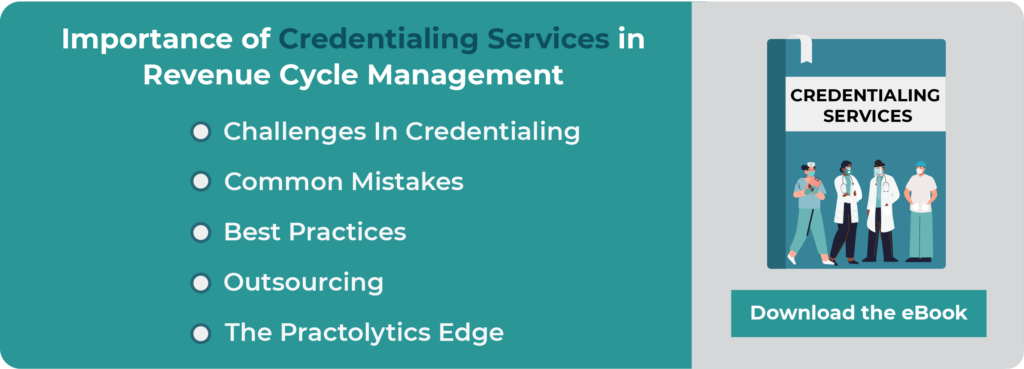Delegated Credentialing Pros and Cons for 2026 Groups
Delegated Credentialing Pros and Cons for 2026 Groups: Delegated credentialing matters for large clinics in 2026. It cuts hiring time, trims paperwork, and fuels growth. But watch for risks: audit troubles, security gaps, and weak checks. This blog explains delegated credentialing—key benefits, dangers, partner choice tips, oversight tricks, and a smooth 90-day start. Written clearly, it helps clinics decide if delegation supports their growth plans. You’ll also find how Practolytics delivers safe, hassle-free credentialing.
Table of Contents
The Pros and Cons of Delegated Credentialing for Large Physician Groups in 2026
Medical credentialing services keep your doctors seeing patients and getting paid. For big practices, handling hundreds of physicians across multiple insurers feels crushing. Delegated credentialing—where insurers allow your group or a CVO partner to handle credentialing—seems appealing. It speeds up hiring, saves staff time, and supports expansion. But it introduces risks that need oversight.
This guide clarifies delegated credentialing: what it is, why practices use it now, its pros and cons, required legal/quality checks, a clear adoption checklist, and setup steps. I use plain language so you move quickly.
What is Delegated Credentialing?
Delegated credentialing lets health plans hand provider checks to groups or vendors. They verify and enroll doctors for the plan. The plan keeps final say on networks and must audit the work. This cuts repeated tasks and puts checks in one spot.
Bodies like NCQA set rules for delegation and audits. These standards guide both payers and their partners.
Why Large Groups Consider Delegation in 2026
A few trends push groups toward delegation today:
Growth demands. Large groups hire more providers, launch new sites, and expand telehealth or multi-state care. Hand-checking credentials slows this growth.
Shared data tools. CAQH, payer APIs, and joint registries simplify data sharing. This makes delegation work better.
Cost pressure strains teams. Credentialing tasks drain time and risk errors. Outsourcing cuts the admin load, freeing staff for patient care.
Regulators now support delegation. Payers accept it when partners meet standards and allow audits. This shift expands the use.
Clear Benefits of Delegated Credentialing
Faster onboarding. Teams build steady processes and payer links. This cuts the provider wait from months to weeks.
Lower admin work. Staff time spent chasing payers, logging into portals, and resending forms drops fast.
Consistency. One skilled team uses the same checklist and checks sources every time.
Scalability. When hiring surges, delegates expand quickly than internal teams.
Tech edge. Delegates often adopt automation, data tools, and dashboards—things smaller groups can’t afford to run.
Real Risks and Downsides you Must Manage
Delegation is serious business. Watch these risks:
Loss of control.
If your delegate slips up, providers lose payments. Your team depends entirely on their accuracy.
Data exposure.
Sharing patient details raises compliance hurdles. Scrutinize encryption, access, and security upfront.
Audit liability.
Regulators still hold your group accountable even with delegation. You own the legal risk—not the delegate.
Service quality suffers.
Bad delegates cause delays, enrollment errors, and claim rejections. This hits profits and trust.
Hidden fees add up.
Low provider rates hide appeal costs, re-credentialing charges, and special payer fees.
Integration pains.
AdvancedMD EHR, payroll, HR, and payer systems must connect smoothly. Poor sync creates double work.
Regulatory and Accreditation Landscape (short)
NCQA and similar groups set rules for outsourced credentialing. If you handle work for their accredited plans, you must follow these rules. This covers checking sources, renewal timelines, and audit trails.
CAQH and other data centers work to improve provider data accuracy and sharing. This helps delegated setups and cuts repeat data entry.
Make sure your contracts mention any relevant accreditation and payer requirements.
How to Decide: Build a Decision Checklist
Before you delegate provider credentialing, think through three business essentials:
- Scale: How many providers do you onboard monthly? High or rising numbers often make delegation the smarter choice.
- Focus: Is credentialing central to your brand promise and patient care, or just routine admin you could hand off?
- Tech Fit: Will your existing EHR and HR software connect smoothly with a partner’s platform?
- Compliance appetite: Do you have auditors and lawyers ready to watch partners?
- Cost model: Compare your total costs (staff, tech, mistakes) against outsourced fees plus add-ons.
- Control needs: What stays under your roof (like hospital privileges) versus what can partners handle?
- Exit plan: How quickly and cleanly can you reclaim credentialing if needed?
If you favor scale, speed, and oversight, try piloting delegation.
Vendor Selection Checklist — What to Ask a Delegate
Use this checklist when assessing vendors:
Credentials & Track Record: Have they handled big multi-location clients or NCQA-approved plans? Can they share client feedback?
Primary Source Checks: Do they verify provider details exactly as payers require? What’s their proof documentation process?
Processing Speed Guarantees: What’s their average time from final records to insurer submission? How long until final approval?
Compliance Transparency: Can they instantly supply audit trails, verification copies, and renewal logs? How frequently do they welcome third-party audits?
Security & HIPAA Compliance: Request SOC2 or ISO audit reports. Explain your encryption for stored and moving data.
Integration Setup: Do you connect via APIs like CAQH/PECOS, or just fax/portals?
Payer Escalations: Confirm direct payer contacts and fast-track issue resolution paths.
Clear Pricing: Disclose all fees—setup, per-provider, appeals, re-credentialing, projects.
Transition Steps: Detail provider onboarding, launch timeline, and backup plans.
Demand Pilot Testing with Concrete KPIs in SLAs.
Governance: how to manage delegated credentialing well
Assign an owner. Make one leader responsible for vendor contacts, audits, and escalations.
Set targets. Measure submission speed, approval time, complete files percentage, re-credentialing timeliness, and mistake rates.
Schedule audits. Check random files and PSV proof every three or six months.
Share data live. Use dashboards to view application status, missing documents, and payer replies instantly.
Feedback loop. Share denial patterns with delegates and clinical teams to solve core issues.
Security checks. Do yearly audits and confirm BAAs are signed.
Better processes. Use data to cut rework and speed approvals.
Typical KPIs to track
- Time from claim sent to payer gets
- Time from claim sent to payer says yes
- Percent filled right the first time
- Count of no-pays from bad credentials
- Percent renew credentials on time
- How happy providers feel about joining
Goal: Cut wait times and boost right-first-time rates step by step.
A Practical Implementation Plan (90 days)
Days 0–15: Get Ready
- Check how we handle credentials now.
- Pick a test group (one specialty or area).
- Set clear goals and rules.
Days 16–45: Pick & Set Up Vendor
- Talk to potential vendors.
- Sign agreements and service promises.
- Plan how data moves and secure approvals.
Days 46–75: Test Drive & Improve
- Bring test partners on board.
- Watch live reports and solve tech problems.
- Hold weekly talks and first review.
Days 76–90: Measure & Grow
- Check results and team feedback.
- Tweak workflows and add more groups.
When not to delegate
- You lack oversight for delegated work (no checks, no owner).
- You need direct control over provider tasks (like hospital privileges).
- Your systems don’t connect, causing repeats and mistakes.
Trends and what to watch in 2026
- Stronger APIs and CAQH adoption streamline real-time checks, cutting manual work.
- Regulators push tougher PSV and re-credentialing rules—stay audit-ready daily.
- Hybrid models grow: teams handle key controls while outsourcing heavy tasks.
- AI spots gaps early, boosting complete submissions on first pass.
Bottom Line: is Delegated Credentialing Right for Your Large Group?
For many big doctor groups, letting a vendor handle credentialing helps them grow quickly, cut paperwork, and use smarter tools. But it demands careful partner picks, solid agreements, firm oversight, and regular checks. Done right, it’s not just a task shift—it’s a team play that lifts your business.
How Practolytics helps
If you’re thinking about delegation, Practolytics handles credentialing from start to finish: cleaning CAQH profiles, verifying providers, and enrolling with payers.
- Your team gets live dashboards and tracked updates for complete visibility.
- We manage data securely under HIPAA rules and sync smoothly with EHR systems.
- Clear service agreements and reports focus on your key goals.
- Choose a hybrid approach: you oversee patient interactions while we tackle admin burdens.
Want a test run or custom checklist? Get a free review of your readiness. See how delegation speeds up onboarding without losing control.






